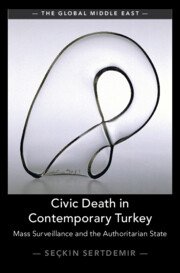6698 results in Middle East government, politics and policy
Copyright page
-
- Book:
- Civic Death in Contemporary Turkey
- Published online:
- 09 January 2025
- Print publication:
- 23 January 2025, pp viii-viii
-
- Chapter
- Export citation
Acknowledgements
-
- Book:
- Civic Death in Contemporary Turkey
- Published online:
- 09 January 2025
- Print publication:
- 23 January 2025, pp xiii-xv
-
- Chapter
- Export citation
1 - Protection
-
- Book:
- Civic Death in Contemporary Turkey
- Published online:
- 09 January 2025
- Print publication:
- 23 January 2025, pp 28-60
-
- Chapter
- Export citation
Figures
-
- Book:
- Civic Death in Contemporary Turkey
- Published online:
- 09 January 2025
- Print publication:
- 23 January 2025, pp xii-xii
-
- Chapter
- Export citation
Contents
-
- Book:
- Civic Death in Contemporary Turkey
- Published online:
- 09 January 2025
- Print publication:
- 23 January 2025, pp xi-xi
-
- Chapter
- Export citation
Dedication
-
- Book:
- Civic Death in Contemporary Turkey
- Published online:
- 09 January 2025
- Print publication:
- 23 January 2025, pp ix-x
-
- Chapter
- Export citation
Conclusion
-
- Book:
- Civic Death in Contemporary Turkey
- Published online:
- 09 January 2025
- Print publication:
- 23 January 2025, pp 159-172
-
- Chapter
- Export citation
Reviews
-
- Book:
- Civic Death in Contemporary Turkey
- Published online:
- 09 January 2025
- Print publication:
- 23 January 2025, pp v-vi
-
- Chapter
- Export citation

The New Israelis
- Ethnicity, Religion, and Nationalism
-
- Published online:
- 18 January 2025
- Print publication:
- 09 January 2025

Civic Death in Contemporary Turkey
- Mass Surveillance and the Authoritarian State
-
- Published online:
- 09 January 2025
- Print publication:
- 23 January 2025
Dedication
-
- Book:
- Constitution-Building After the Arab Spring
- Published online:
- 31 December 2024
- Print publication:
- 09 January 2025, pp vii-viii
-
- Chapter
- Export citation
Preface
-
- Book:
- Millennial Dreams in Oil Economies
- Published online:
- 02 January 2025
- Print publication:
- 09 January 2025, pp xiii-xv
-
- Chapter
- Export citation
5 - Constructing Belonging and Contesting Economic Space
-
- Book:
- Millennial Dreams in Oil Economies
- Published online:
- 02 January 2025
- Print publication:
- 09 January 2025, pp 203-241
-
- Chapter
- Export citation
4 - Religion, Non-Muslims, and Women
-
- Book:
- Constitution-Building After the Arab Spring
- Published online:
- 31 December 2024
- Print publication:
- 09 January 2025, pp 189-267
-
- Chapter
- Export citation
Contents
-
- Book:
- Millennial Dreams in Oil Economies
- Published online:
- 02 January 2025
- Print publication:
- 09 January 2025, pp vii-viii
-
- Chapter
- Export citation
Copyright page
-
- Book:
- Millennial Dreams in Oil Economies
- Published online:
- 02 January 2025
- Print publication:
- 09 January 2025, pp vi-vi
-
- Chapter
- Export citation
2 - Systems of Government and Distribution of Powers
-
- Book:
- Constitution-Building After the Arab Spring
- Published online:
- 31 December 2024
- Print publication:
- 09 January 2025, pp 63-139
-
- Chapter
- Export citation
Copyright page
-
- Book:
- The New Israelis
- Published online:
- 18 January 2025
- Print publication:
- 09 January 2025, pp iv-iv
-
- Chapter
- Export citation
An Epilogue
-
- Book:
- The New Israelis
- Published online:
- 18 January 2025
- Print publication:
- 09 January 2025, pp 275-299
-
- Chapter
- Export citation
5 - The Religious Turn
-
- Book:
- The New Israelis
- Published online:
- 18 January 2025
- Print publication:
- 09 January 2025, pp 162-198
-
- Chapter
- Export citation

